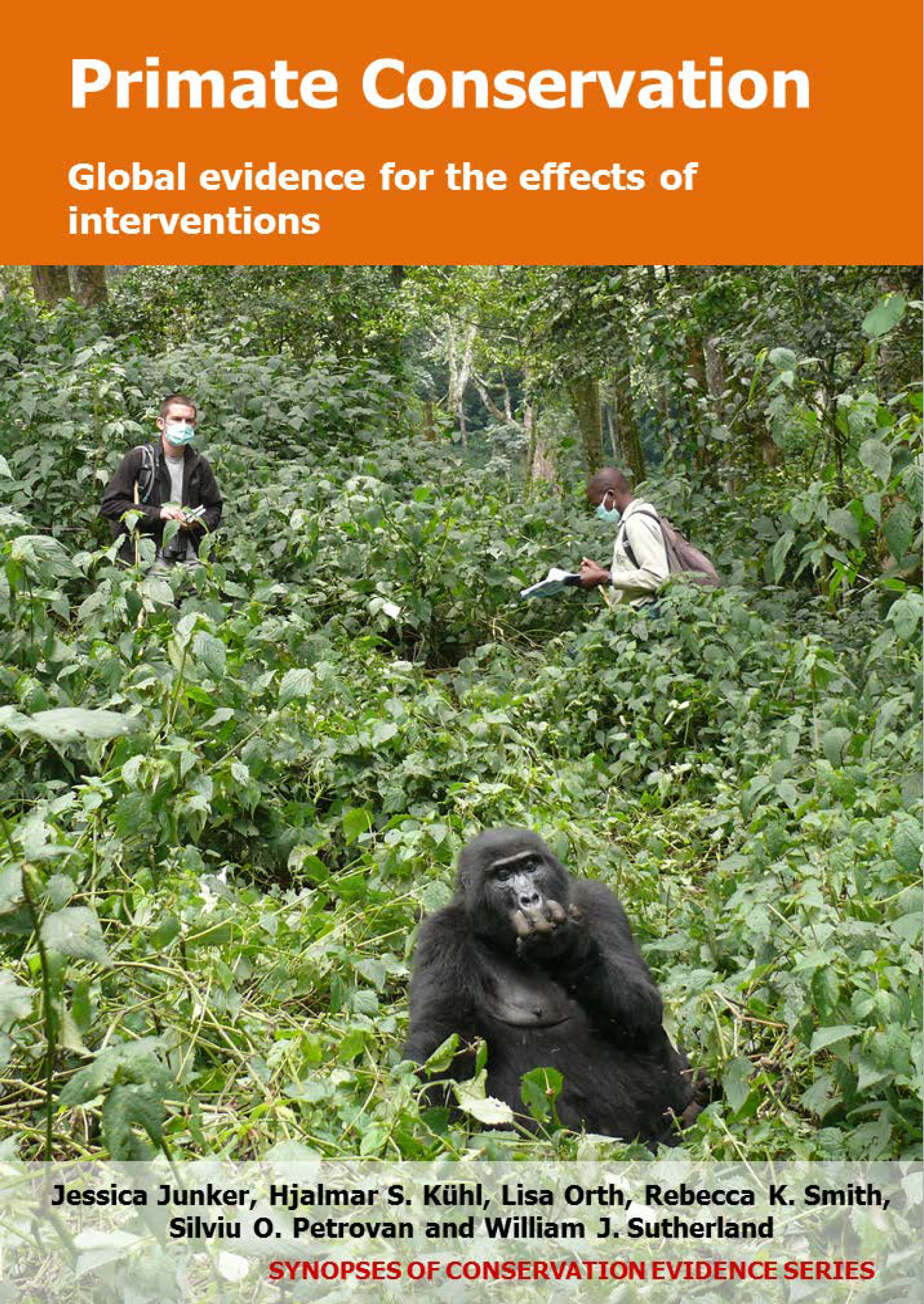Implement legal protection for primate species under threat
-
Overall effectiveness category Unknown effectiveness (limited evidence)
-
Number of studies: 5
View assessment score
Hide assessment score
How is the evidence assessed?
-
Effectiveness
40% -
Certainty
30% -
Harms
0%
Study locations
Supporting evidence from individual studies
A before-and-after trial in 1959-1987 in Aligarh district, Uttar Pradesh, India found that a rhesus macaque Macaca mulatta population recovered after implementing a national ban on its commercial export. The population increased from 163 monkeys in 1970 to an average of 396 monkeys in 1985-1987 (143% increase). Furthermore, in 1985-1986, 46.1% of the total population was immature (infants or juveniles) compared to 31.1% in 1959-1960, indicating a growing population. No statistical tests were carried out to determine whether this increase was significant. During the first census in 1962, the population of 403 individuals consisted of 21 groups. Since 1970, eight groups survived for at least 18 years. The Indian government banned commercial exports of rhesus macaques in April 1978. The improvement of agricultural production could have been partly responsible for the recovery of the monkey population (no data provided). Surveys across the state of Uttar Pradesh also revealed a population increase (133% increase) as encounter rates increased from 21 monkeys/100 km in 1977-1978 to 49 monkeys/100 km in 1985-1986; no statistical tests were carried out to determine whether this increase was significant. Population censuses were conducted by car, bicycle and by foot in and around villages and forests.
Study and other actions testedA study, which was included in a review, in 1967-1970 in Koh Klet Kaeo island and Sai Yok National Park, Thailand of lar gibbons Hylobates lar that were legally protected in 1961 along with other interventions and that were reintroduced from captivity found that the introduced population of 20 individuals decreased to eight individuals (60% decrease) over three years. No statistical tests were carried out to determine whether this difference was significant. However, four infants were born over the same time period. Gibbons were introduced in pairs into habitat that did not resemble their natural habitat and without resident gibbons. Gibbons were obtained individually from animal dealers and housed together in a laboratory for at least one month before release. They were supplemented with food and water. In dry evergreen forest in Sai Yok National Park, two introduced gibbons of a total of 31 individuals died (6% decrease) within three years post-release and no infants were born in the first 17 months. Four gibbons joined wild groups. They were introduced as individuals, pairs, or family groups into habitat with resident conspecifics. Anaesthetized gibbons were either kept in separate cages for 14 days before release, or laid out on the forest floor. Injured animals were recaptured and treated. The study does not distinguish between the effects of the different interventions.
Study and other actions testedA before-and-after trial in 1976-1988 in a degraded tropical forest in Semenggoh Forest Reserve, Malaysia found that at least 77 of 87 (90%) reintroduced captive, wild-born Müller's Bornean gibbons Hylobates muelleri that were legally protected in the area along with other interventions, did not survive after release. Müller's Bornean gibbons were fully protected under the Wild Life Protection Ordinance in Sarawak that also forbade keeping gibbons as pets. Confiscated gibbons had undergone veterinary checks and were placed in holding cages in a forest clearing for an unknown amount of time. Where possible, males and females were paired in cages prior to release into habitat without wild resident gibbons. Surveys of direct sightings and gibbon calls along grid squares (500 x 500 m) covering a total of 9.5 km were conducted simultaneously by three or four observers on non-rainy days in February-March 1988. The study does not distinguish between the effects of the different interventions mentioned above.
Study and other actions testedA site comparison in 1971-2002 in five tropical forests with different management histories in Bakossiland, Cameroon found that drill Mandrillus leucophaeus populations that were officially protected by government legislation, decreased in numbers on Mount Mwanenguba, the Bakossi- and Mwenzekong Mountains, became extinct in the Loum Forest Reserve, and appeared to recover only on Mount Kupe. Drill group sizes did not change significantly over time, season, habitat, or elevation for Mount Kupe, or for all sites combined. Independent direct observations of drills groups and their size were recorded at all sites by different organizations working in the region.
Study and other actions testedA study in 1991-2007 in tropical forests in Karbi Anglong district, Assam, northeast India found that the hoolock gibbon Hoolock hoolock population decreased by 33% over 16 years, despite being officially protected in India. Overall, the population declined from 3,500-4800 gibbons in 1991-1992 to 2,400-3,200 gibbons in 2007 (33% decrease). However, no statistical tests were carried out to determine whether this decrease was significant. The species is protected under Schedule-1 of the Wild Life (Protection) Act of India, which prohibits its killing or capture, dead or alive. However, the enforcement of this act appeared virtually non-existent, even in protected areas. Data on gibbon distribution and approximate population sizes were collected through field surveys along trails, roads and rivers and interviews of local forest staff, villagers and hunters.
Study and other actions tested
Where has this evidence come from?
List of journals searched by synopsis
All the journals searched for all synopses
This Action forms part of the Action Synopsis:
Primate Conservation
Primate Conservation - Published 2017
Primate Synopsis





)_2023.JPG)














